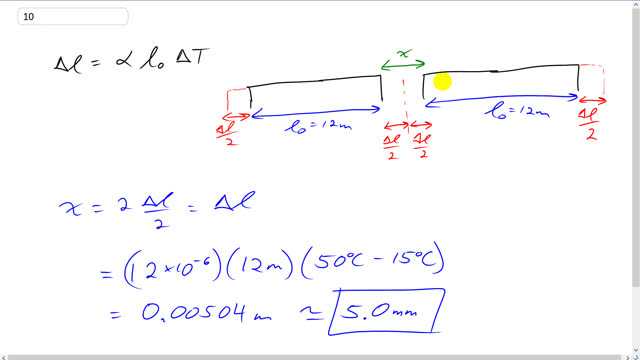
A concrete highway is built of slabs 12 m long . How wide should the expansion cracks between the slabs be at to prevent buckling if the range of temperature is to ?

In order to watch this solution you need to have a subscription.
This is Giancoli Answers with Mr. Dychko. Here's 1 concrete slab here of length 12 meters and another concrete slab 12 meters. In the winter these slabs will contract and reduce their their length and they're not going to be any danger of buckling from that. So, we don't need to think about the low winter temperature. We have to worry only about the high summer temperature of 50 degrees Celsius. And when that 50 degrees happens, each concrete slab will expand and it'll expand equally in both directions. And so will expand some amount, Δl, and half of that expansion will go on one end and half the other expansion will go on the other end. And half the expansion of 1 slab plus half the expansion in the other slab, in total needs to just equal this gap, x, between them. So, x is going to be 2 times Δl over 2 which is just Δl. So, the entire expansion of 1 slab as it turns out. So, we have the coefficient of linear expansion for concrete of 12 times 10 to the minus 6 times the slab's original length of 12 meters when it's at 15 degrees Celsius, multiplied by the change in temperature 50 degrees Celsius minus 15. And that gives about 5.0 millimeters which is a very small gap between the slabs.
Mr. Dychko,
The range of temperatures stated in the problem are from -30 degrees C to 50 degrees C. Thus, shouldn't the change in temperature, or delta(T), be 80 degrees C?
With this value of delta(T), the width of the expansion cracks become 12 mm.
Hi rdattafi, thank you for your question. It turns out that this question calls for a very careful reading since the way it's worded is a bit sneaky. It mentions wanting to know the expansion gap needed at . This expansion gap is needed to deal with the concrete slabs becoming bigger as they get hotter on hot days. The temperatures cooler than don't concern us since the slabs will only get smaller as they get cooler. is a red herring and we can ignore it. The question is not asking "by how much will the concrete expand when changing temperature from to ". Rather, it's asking for how much of a gap should be left between slabs that are so that they don't touch and then buckle when they reach .
Best wishes with your studies,
Mr. Dychko